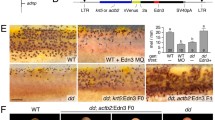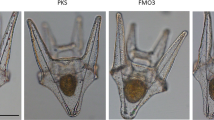Abstract
Albino Apostichopus japonicus occur both in the wild and in captivity. The offspring of albino A. japonicus also suffer from albinism. The formation of melanin in the melanocytes is dependant on microphthalmia-associated transcription factor (MITF). To investigate the role of MITF in controlling albinism, we cloned the full-length MITF cDNA from A. japonicus and compared MITF mRNA expression in albino and normal A. japonicus. In addition, we used light and electron microscopy to compare histological samples of normal and albino A. japonicus. The body wall of albino adults was characterized by significantly lower levels of MITF expression and lower numbers of epidermal melanocytes, which also contained less melanin. In albino juvenile offspring, MITF expression levels were significantly lower 32 d after fertilization and there were fewer, and less developed, epidermal melanocytes. Thus, we conclude that albino A. japonicus have fewer melanocytes and a reduced ability to synthesize melanin, likely because of lower expression of MITF.
Similar content being viewed by others
References
Aberdam E, Bertolotto C, Sviderskaya E V, Thillot V, Hemesath T J, Fisher D E, Bennett D C, Ortonne J P, Ballotti R. 1998. Involvement of microphthalmia in the inhibition of melanocyte lineage differentiation and of melanogenesis by agouti signal protein. J. Biol. Chem., 273: 19 560–19 565.
Amiel J, Watkin P M, Tassabehji M, Read A P, Winter R M. 1998. Mutation of the MITF gene in albinism-deafness syndrome (Tietz syndrome). Clin. Dysmorphol., 7: 17–20.
Arthur J K, Kathleen A T, John J G. 2005. Effect of sunlight intensity and albinism on the covering response of the Caribbean sea urchin Tripneustes ventricosus. Mar. Biol., 146: 1 111–1 117.
Barbosa A J A, Castro L P F, Margarida A, Nogueira M F. 1984. A simple and economical modification of the masson-fontana method for staining melanin granules and enterochromaffin cells. Stain Tech., 59: 193–196.
Colin R G. 2007. Melanocytes: The new Black. Int. J. Biochem. Cell Biol., 39: 275–279.
Fukuzawa T, Ide H. 1986. Further studies on the melanophores of periodic albino mutant of Xenopus laevis. J. Embryol. Exp. Morph., 91: 65–78.
Gaitanis G, Chasapi V, Velegraki A. 2005. Novel application of the Masson-Fontana stain for demonstrating Malassezia species melanin-like pigment production in vitro and in clinical specimens. J. Clin. Microbiol., 43: 4 147–4 151.
Guo H, Huang B, Qi F, Zhang S. 2007. Distribution and ultrastructure of pigment cells in the skins of normal and albino adult turbot, Scophthalmus maximus. Chin. J. Oceanol. Limnol., 25: 199–208.
Hyman L H. 1955. The Invertebrates: Echinodermata. McGraw-Hill Press, New York.
Ichiro Y, Kosuke E, Shigeru S, Reiko T, Hiroshi W, Shigeki S, Takaharu N, Kazuho I, Takashi G, Colin R G, Hiroaki Y. 2003. Cloning and functional analysis of ascidian Mitf in vivo: insights into the origin of vertebrate pigment cells. Mech. Dev., 120: 1 489–1 504.
Jiri V, Jan B. 2010. “Transcription physiology” of pigment formation in melanocytes: central role of MITF. Exp. Derm., 19: 617–627.
Kazuhisa T, Clifford T, Ichiro K, Atsushi W, Yoshitaka N, David E F, Masayoshi T. 2000. Ser298 of MITF, a mutation site in Waardenburg syndrome type 2, is a phosphorylation site with functional significance. Hum. Mol. Genet., 9: 125–132.
Levy C, Khaled M, Fisher D E. 2006. MITF: master regulator of melanocyte development and melanoma oncogene. Trends Mol. Med., 12: 406–414.
Nakayama A, Nguyen M T, Chen C C, Opdecamp K, Hodgkinson C A, Arnheiter H. 1998. Mutations in microphthalmia, the mouse homolog of the human deafness gene MITF, affect neuroepithelial and neural crest-derived melanocytes differently. Mech. Dev., 70: 155–166.
Nolan M R, Robert S Jr. 1990. Autosomal albinism affects immunocompetence in the chicken. Devel. Comp. Immunol., 14: 105–112.
Opdecamp K, Nakayama A, Nguyen M T, Hodgkinson C A, Pavan W J, Arnheiter H. 1997. Melanocyte development in vivo and in neural crest cell cultures: crucial dependence on the Mitf basic-helix-loop-helix-zipper transcription factor. Devel., 124: 2 377–2 386.
Seldenrijk R, Huijsman K G H, Heussen A M A, Vandeveerdonk F C G. 1982. A comparative ultrastructural and physiological study on melanophores of wild-type and periodic albino mutants of xenopus-laevis. Cell Tissue Res., 222: 1–9.
Spritz R A, Chiang P W, Oiso N, Alkhateeb A. 2003. Human and mouse disorders of pigmentation. Curr. Opin. Gen. Devel., 13: 284–289.
Takeda K, Yasumoto K, Takada R, Takada S, Watanabe K, Udono T, Saito H, Takahashi K, Shibahara S. 2000. Induction of melanocyte-specific microphthalmia-associated transcription factor by Wnt-3a. J. Biol. Chem., 275: 14 013–14 016.
Tassabehji M, Newton V E, Read A P. 1994. Waardenburg syndrome type 2 caused by mutations in the human microphthalmia (MITF) gene. Nature Genet., 8: 251–255.
Tassabehji M, Newton V E, Liu X Z, Brady A, Donnai D, Krajewska-Walasek M, Murday V, Norman A, Obersztyn E, Rice J C. 1995. The mutational spectrum in Waardenburg syndrome. Hum. Mol. Genet., 4: 2 131–2 137.
Wang J, Hou L, Zhang R, Zhao X, Jiang L, Sun W, An J, Li X. 2007. The tyrosinase gene family and albinism in fish. Chin. J. Oceanol. Limnol., 25: 191–198.
Wasmeier C, Hume A N, Bolasco G, Seabra M C. 2008. Melanosomes at a glance. J. Cell. Sci., 121: 3 995–3 999.
William S O. 2000. The tyrosinase gene and Oculocutaneous Albinism Type 1 (OCA1): a model for understanding the molecular biology of melanin formation. Pigm. Cell. Res., 13: 320–325.
Yang H, Yuan X, Zhou Y, Mao Y, Zhang T, Liu Y. 2005. Effects of body size and water temperature on food consumption and growth in the sea cucumber Apostichopus japonicus (Selenka) with special reference to aestivation. Aquac. Res., 36: 1 085–1 092.
Author information
Authors and Affiliations
Corresponding author
Additional information
Supported by the National Natural Science Foundation of China (No. 40976089), the National Marine Public Welfare Research Project (No. 200805069), the National Science and Technology Support Program of China (No. 2011BAD13B02), and the Breeding Project of Shandong Province (China)
Rights and permissions
About this article
Cite this article
Zhao, H., Yang, H., Zhao, H. et al. Differences in MITF gene expression and histology between albino and normal sea cucumbers (Apostichopus japonicus Selenka). Chin. J. Ocean. Limnol. 30, 80–91 (2012). https://doi.org/10.1007/s00343-012-1043-9
Received:
Accepted:
Published:
Issue Date:
DOI: https://doi.org/10.1007/s00343-012-1043-9




